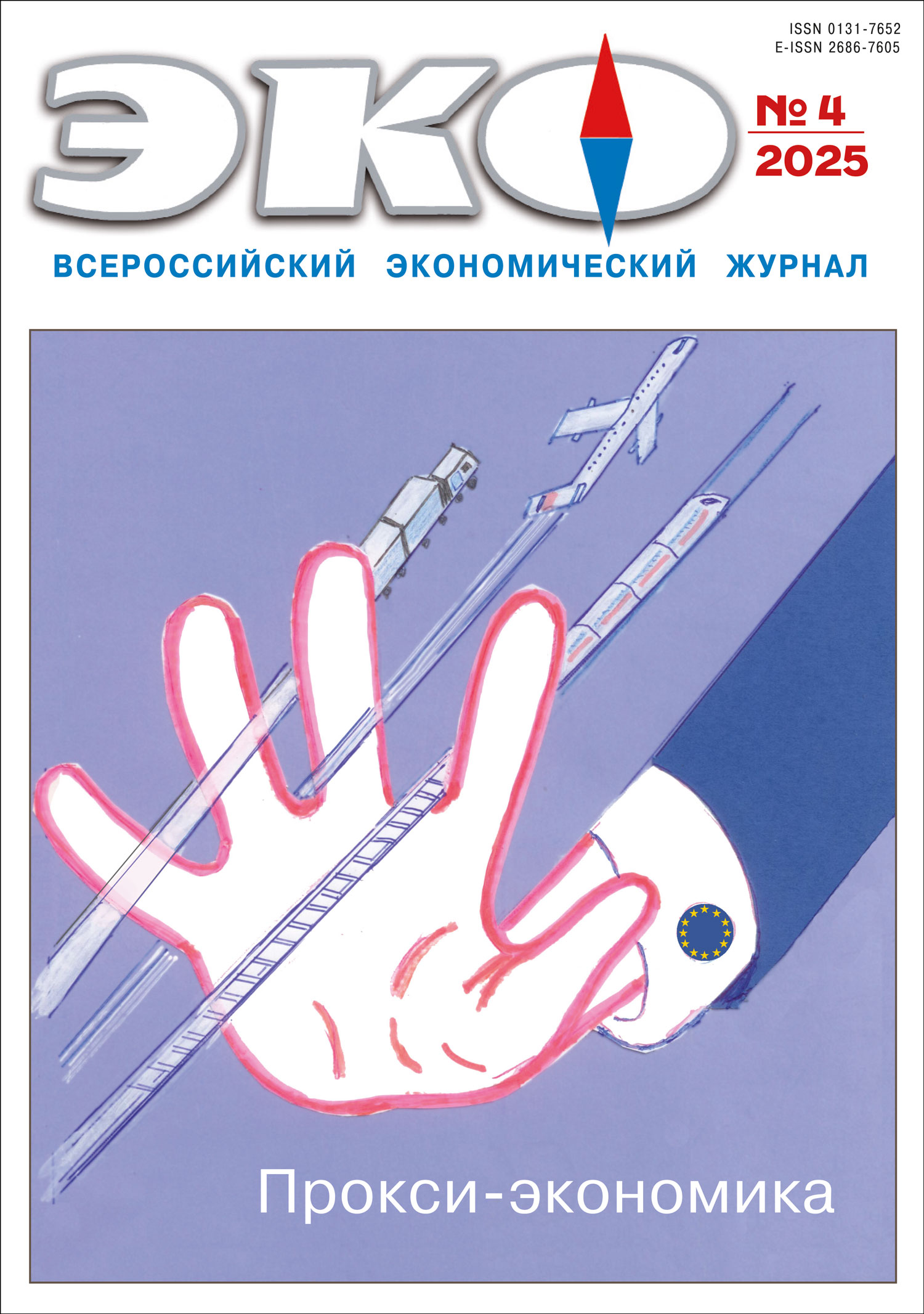REGIONAL DEVELOPMENT
Mechanisms for Planning and Implementing Transportation Strategies at the Municipal Level
Published 2025-07-24
Keywords
- Sverdlovsk region; transport planning; municipality; transport infrastructure; Metro; EKAD; dry port
How to Cite
1.
Pasynkov А, Uporov В. Mechanisms for Planning and Implementing Transportation Strategies at the Municipal Level. ECO [Internet]. 2025 Jul. 24 [cited 2025 Dec. 20];55(4):167-82. Available from: https://ecotrends.ru/index.php/eco/article/view/4887
Abstract
Transportation and its infrastructure perform important tasks in the life of any municipality and directly affect its development. The paper considers domestic and foreign approaches to transportation planning at the level of municipalities. The administrative regulation of strategic planning at the federal, regional and municipal levels in the Russian Federation, the role and place of the transportation block in the strategies of socio-economic development of municipalities are studied. The authors analyze transport facilities in the cities of Yekaterinburg, Nizhny Tagil and Kamensk-Uralsky as the most striking examples of implemented and unrealized projects included in the prospective plans of socio-economic development of territories. The authors explain the existing mechanisms of transport strategies implementation, their interrelation with the strategic documents of municipalities and consider the main options for improving the efficiency of planning and implementation.References
- Бардаль А Б. Транспортный комплекс: опыт регионального стратегического планирования // Власть и управление на Востоке России. 2016. № 3(76). С. 20–27.
- Бочко В.С., Захарчук Е.А. Индивидуализация стратегий развития городов (на примере Екатеринбурга и Бирмингема) // Экономика региона. 2020. Т. 16. № 2. С. 391–405. DOI: 10.17059/2020–2–5
- Брязгина Е.О., Казьмин Д.М. Планирование инвестиций федерального бюджета в транспортную инфраструктуру // Транспорт Российской Федерации. 2019. № 5(84). С. 3–7.
- Гатиятуллин М.Х., Дегтярев А.А. Основы транспортного планирования // Техника и технология транспорта. 2019. № 4(15). С. 10.
- Донченко В.В. Доступность и методы её оценки в процессах планирования городских транспортных систем // Автомобиль. Дорога. Инфраструктура. 2023. № 1(35). С. 19.
- Каменков А.Л. Улучшение оценки рисков внедрения цифровизации на железной дороге с помощью методов SWOT и FWEA-анализа // Ученые записки Международного банковского института. 2020. № 4(34). С. 52–63.
- Концептуальные основы формирования и реализации проекта «Урал промышленный-Урал Полярный» / Под общ. ред. А.И. Татаркина. М.: Экономика, 2007. 361 с.
- Лаврикова Ю.Г., Петров М.Б., Кожов К.Б. Сухой порт Северного морского пути в концепции формирования Урало-Арктического сектора России // Экономика региона. 2024. № 20(2). С. 574–590. DOI: 10.17059/ekon.reg.2024–2–15
- Омаров А.З., Абдулаев М.Н., Шапиева Х.М. Совершенствование методов транспортного планирования при оценке социально-экономических эффектов развития инфраструктурных проектов дорожного хозяйства // Транспортное дело России. 2021. № 4. С. 103–105. DOI: 10.52375/20728689_2021_4_103
- Палкина Е.С., Пономаренко О.А. Формирование системы управления изменениями в железнодорожной пассажирской организации // Ученые записки Международного банковского института. 2021. № 3(37). С. 142–156.
- Раков Д.А., Круглова И.А. Инструменты стратегического планирования развития Транспортной Отрасли в аспекте цифровизации экономики // Ученые записки Международного банковского института. 2023. № 2(44). С. 91–106.
- Трифонова П.С. Основные стратегические документы субъектов российской федерации: анализ, актуализация, индивидуализация // Вестник университета. 2021. № 6. С. 31–43. DOI: 10.26425/1816–4277–2021–6–31–43
- Bertolini, L. (2017). Planning the Mobile Metropolis: Transport for People, Places and the Planet. Bloomsbury Publishing. 224 p.
- Cervero, R. (2001). Efficient urbanisation: Economic performance and the shape of the metropolis. Urban Studies. Vol. 38(10). Pp. 1651–1671. https://doi.org/10.1080/00420980120084804
- Jin, J., Jin, E. (2015). The Effects of Changes in Subway System and Job Accessibility on Changes in Employment Density of Employment Centers in Seoul. Journal of Korea Planning Association. Vol. 50. No. 7. Pp. 111–130. https://doi.org/10.17208/jkpa.2015.11.50.7.111
- John, K. Stanley (2014). Land use/transport integration: Starting at the right place. Research in Transportation Economics. Vol. 48. Pp. 381–388. https://doi.org/10.1016/j.retrec.2014.09.067
- John, K. Stanley (2023). Opportunity equity in strategic urban land use transport planning: Directions in London and Vancouver. Transport Policy. Vol. 136. Pp. 137–146. https://doi.org/10.1016/j.tranpol.2023.03.019
- Jones, P., Lucas, K. (2012). The social consequences of transport decision-making: clarifying concepts, synthesising knowledge and assessing implications. Journal of Transport Geography. Vol. 21. Pp. 4–16. https://doi.org/10.1016/j.jtrangeo.2012.01.012
- LeClair, K., Tiznado-Aitken, I., Klumpenhouwer, W., Farber, S. (2023). A web-based tool to incorporate social equity in infrastructure planning and delivery. Case Studies on Transport Policy. Vol. 13. P. 101068. https://doi.org/10.1016/j.cstp.2023.101068
- Lee, J. (2018). Spatial ethics as an evaluation tool for the long-term impacts of mega urban projects: An application of spatial ethics multi-criteria assessment to Canning Town regeneration projects. International Journal of Sustainable Development and Planning. Vol. 13(4). Pp. 541–555. DOI: 10.2495/SDP-V13-N4–541–555
- Lee, J., Arts, J., Vanclay, F. (2021). Stakeholder views about Land Use and Transport Integration in a rapidly-growing megacity: Social outcomes and integrated planning issues in Seoul. Sustainable Cities and Society. Vol. 67. https://doi.org/10.1016/j.scs.2021.102759
- Randolph, B. (2006). Delivering the compact city in Australia: Current trends and future implications. Urban Policy and Research. Vol. 24(4). Pp. 473–490. https://doi.org/10.1080/08111140601035259

